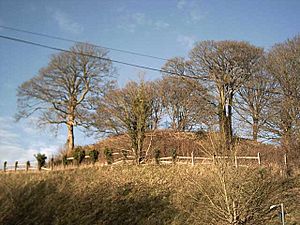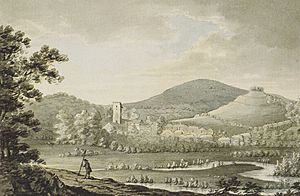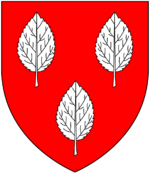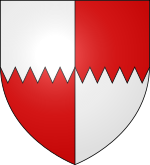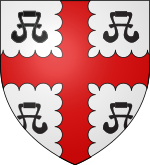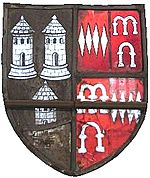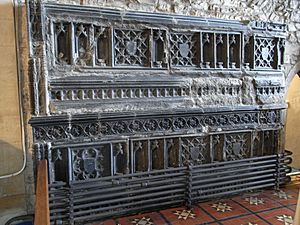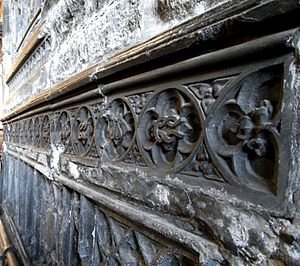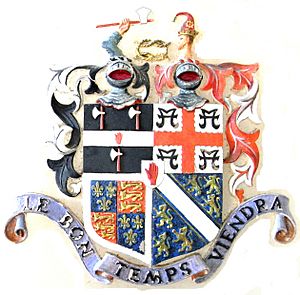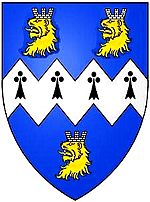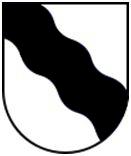Feudal barony of Bampton facts for kids
The feudal barony of Bampton was an important land area in Devonshire, England, during the Middle Ages. It was controlled by powerful lords and its main castle, Bampton Castle, was located in the town of Bampton. This castle was the headquarters for the barony.
Contents
- Who Owned Bampton Castle?
- Early Owners: Domesday Book Times
- The Paynel Family Takes Over
- The Ballon Family's Turn
- The Cogan Family Arrives
- The FitzWarin Family's Rule
- The Hankford Family Connection
- The Bourchier Family: Powerful Lords
- The Wrey Family Inherits
- Other Owners: Tristram, Arnold, and Fellowes
- The Wallop/Fellowes Connection
Who Owned Bampton Castle?
Early Owners: Domesday Book Times
The Domesday Book, a famous survey from 1086, lists "Baentone" as one of 27 Devon properties owned by Walter of Douai. Walter was also a powerful lord in Somerset. He built a castle at Bampton, and you can still see its mound today.
Bampton was a very large estate with 76 households. Before William the Conqueror took over England in 1066, it belonged directly to King Edward the Confessor and didn't pay taxes. Walter received Bampton from William the Conqueror in exchange for other lands.
Some smaller areas that were part of the Bampton barony included Duvale, Hele, Doddiscombe, Hockworthy, Hawkerland, and Lea Barton. Walter owned most of Bampton directly, but he had three tenants who held some land within the estate.
Walter of Douai's son, Robert of Douai, rebelled against King Stephen in 1136. Because of this, his lands went to his daughter, Juliana. Juliana of Douai then married Fulk Paynel.
The Paynel Family Takes Over
The Paynel family became the next feudal barons of Bampton.
- Fulk Paynel (died around 1165) was the husband of Juliana of Douai.
- Fulk Paynel (died 1208) inherited the lands. In 1180, he offered a large sum of money to inherit his father's lands. However, he fled England in 1185, and the barony returned to the king. It was given back to Fulk in 1199 after he paid another large sum.
- William Paynel (died 1228) was Fulk's son. He also paid a fee to inherit. He married Alice Brewer, who was the daughter of a powerful sheriff of Devon, William Brewer.
- William Paynel (died 1248) was the last male Paynel owner. His heir was his sister, Auda Paynell (died 1261). She was married to John de Ballon, a feudal baron from Herefordshire.
The Ballon Family's Turn
The Ballon family first came to England with brothers Wynebald and Hamelin de Ballon. They were from a strong castle called "The Gateway to Maine" in France.
- John de Ballon (died 1275) became the feudal baron of Bampton through his wife, Auda Paynel. He had to pay £100 to inherit his brother-in-law William Paynel's lands. John and Auda had no children. After Auda died in 1261, the barony was looked after by Edmund of Lancaster, King Henry III's son, until 1267.
The Cogan Family Arrives
- John de Cogan (died 1302) received the barony from Edmund of Lancaster in 1267. John was the grandson of Fulk Paynel (who died in 1208). The Cogans held their lands at Bampton by providing the service of one knight. A historian named Risdon said that the Cogans had a "very stately house" at Bampton and often lived there, even though they had more land in Ireland.
- Thomas de Cogan (died 1315) was John's son and heir.
- Richard de Cogan (1299–1368) got royal permission in 1336 to add battlements to his house at Bampton. He also got permission to enclose his wood and 300 acres of land to create a deer park. The house was likely near the castle, but no parts of it remain today. It was the home of the Cogans and later families until the Bourchiers. Richard married Mary Montagu.
- John Cogan (died 1382) died as a minor (underage) and was under the king's care. He was the son of Sir William Cogan. John's heir was his sister, Elizabeth Cogan. She was married to Fulk FitzWarin, 5th Baron FitzWarin (1362–1391). Through his mother, Fulk was also the heir to the manor of Tawstock, which later became the main home of the Bourchier family.
The FitzWarin Family's Rule
The FitzWarin family were powerful lords who guarded the borders of England, based at Whittington Castle in Shropshire. The title "Baron FitzWarin" was created by a royal order in 1295.
- Fulk FitzWarin, 5th Baron FitzWarin (1362–1391) was the husband of Elizabeth Cogan, who brought Bampton to the family.
- Fulk FitzWarin, 6th Baron FitzWarin (1389–1407) was their son.
- Fulk FitzWarin, 7th Baron FitzWarin (1406–1420) was his son. He died at age 14, and his heir became his sister, Elizabeth FitzWarin.
- Elizabeth FitzWarin, 8th Baroness FitzWarin (around 1404 – around 1427) was the sister. She married Richard Hankford. When she died, the barony was "on hold" between her daughters, Thomasine Hankford (1423–1453) and Elizabeth Hankford (around 1424 – 1433). When Elizabeth died in 1433, Thomasine became the 9th Baroness.
The Hankford Family Connection
Sir Richard Hankford (around 1397 – 1431) married Elizabeth FitzWarin, the 8th Baroness FitzWarin. After her death, their daughter Thomasine Hankford (1423–1453) became the 9th Baroness.
The Bourchier Family: Powerful Lords
The Bourchier family, who later became the Earls of Bath, owned Bampton for a long time. A historian named Risdon (who died in 1640) wrote that "the Earl of Bath is lord of this manor."
- William Bourchier, 9th Baron FitzWarin (1407–1470) married Thomasine Hankford (1423–1453). He was the second son of William Bourchier, who was related to King Edward III. William Bourchier was called to Parliament as Lord FitzWarin because of his wife, making him the 9th Baron FitzWarin. Thomasine was buried in Bampton Church. Parts of a tomb there, showing Bourchier Knots and water bougets, are believed to be hers.
- Fulk Bourchier, Baron FitzWarin (died 1480) was William's son. He asked to be buried at Bampton near his parents. He married Elizabeth Dinham. A stained glass window in Bampton church shows the arms of Sapcotes combined with Dinham, as Elizabeth later remarried Sir John Sapcotes.
- John Bourchier, 1st Earl of Bath (1470–1539) was Fulk's son. He was made the Earl of Bath in 1536. His grand tomb with statues of himself, his wife, and their eight children was in Bampton Church until it was destroyed after 1770.
- John Bourchier, 2nd Earl of Bath (1499–1561) was John's son.
- William Bourchier, 3rd Earl of Bath (before 1557–1623) was John's grandson. By his time, the family's main home was at Tawstock. He is buried there, and his magnificent tomb and statue can still be seen.
The Wrey Family Inherits
The Wrey family inherited the Bourchier lands. When Henry Bourchier, 5th Earl of Bath (died 1654) passed away without male heirs, the title of Earl of Bath ended. The Bourchier lands were then shared by the three daughters of his cousin, Edward Bourchier, 4th Earl of Bath (1590–1636).
Lady Anne Bourchier (born 1631), one of these daughters, married Sir Chichester Wrey, 3rd Baronet. His family inherited the main Bourchier home at Tawstock. A biographer named John Prince (died 1723) wrote that in his time, most of Bampton still belonged to the family of the former Earls of Bath and was the "noble seat" of Lady Wrey, the widow of Sir Bourchier Wrey, 4th Baronet.
Other Owners: Tristram, Arnold, and Fellowes
An old house near Bampton Castle, called Castle Grove, was home to the Tristram family. They likely bought it from the Bourchiers. A memorial for John Tristram (1668–1722) is in the parish church. By 1822, the castle site belonged to Robert Lucas, who was an heir to the Tristram family.
In 1720, William Arnold owned the manor of Bampton.
Later in 1720, William Fellowes (died 1724) and his brother Sir John Fellowes, 1st Baronet (died 1724) bought the manor of Bampton from William Arnold. Sir John Fellowes, who was important in the South Sea Company, died without children.
William Fellowes died in 1723 and was buried at Eggesford, where a classical-style monument remains. His elder son, Coulson Fellowes (1696–1769), married Urania Herbert. Their marriage agreement in 1725 meant he had to transfer many lands, including the manor of Bampton, to trustees for his male heirs.
Coulson Fellowes later married Lavinia Smyth and had children, including William Henry Fellowes (1769–1837). The Devon properties, including Bampton, passed to his younger son, Henry Arthur Fellowes, who died in 1792.
The Wallop/Fellowes Connection
By 1822, the barony of Bampton was owned by the Honourable Newton Fellowes (1772–1854). He was born Newton Wallop, the younger son of John Wallop, 2nd Earl of Portsmouth. He changed his name to Fellowes after inheriting the Fellowes estates, which included Eggesford and Bampton. He eventually became the 4th Earl of Portsmouth after his older brother passed away.



